
In addition to #AgDay2018, today is also Bring Your Child to Work Day at CDFA. Secretary Ross greeted the children of agency employees and read them a story, “Who Grew My Soup?”



In addition to #AgDay2018, today is also Bring Your Child to Work Day at CDFA. Secretary Ross greeted the children of agency employees and read them a story, “Who Grew My Soup?”

Our annual Ag Day is today (March 20) at the State Capitol, and our theme this year, “Climate Smart – California Grown,” is far more than a slogan. It’s actually a key part of the road map for the future of farming and ranching in our state. CDFA and the Brown Administration share a essential priority with agriculture – keep it sustainable and flourishing into the 21st century and beyond.
There is a strong likelihood that California will be asked to produce more food in the coming years while dealing with access to fewer natural resources, so we are embracing that challenge with several programs that are assisting rural communities while helping farmers and ranchers increase water efficiency and energy efficiency, and reduce greenhouse gas emissions.
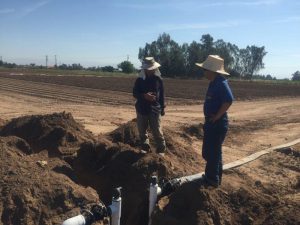
Hmong farmers in Fresno County are among those receiving SWEEP grants to improve water efficiency and reduce greenhouse gas emissions.
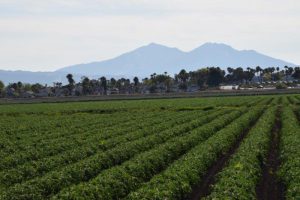
Farmland in Contra Costa County protected by a SALC conservation easement. Photo courtesy of the Cecchini family.
The California Climate Investment programs for agriculture demonstrate the extreme importance of working and natural landscapes in our overall climate strategy. We must align with all of our state’s citizens and show them that we’re all in this together; that sustainable agriculture means wholesome, healthy California-grown food for many years to come. Ag Day is another way to make that point. Hope to see you there! (Open to the public at 11:30 am)
 In 2016 California’s farms and ranches received more than $46 billion for their output. This represents a decrease of about six percent compared to 2015. Despite this decrease, California remains the leading US state for cash farm receipts.
In 2016 California’s farms and ranches received more than $46 billion for their output. This represents a decrease of about six percent compared to 2015. Despite this decrease, California remains the leading US state for cash farm receipts.
For the 2016 crop year California agricultural exports totaled $20.04 billion. Top commodities for export included almonds, wine, dairy and dairy products, walnuts and pistachios. Export statistics are produced by the University of California, Davis, Agricultural Issues Center.
California’s agricultural abundance includes more than 400 commodities. Over a third of the country’s vegetables and two-thirds of the country’s fruits and nuts are grown in California. California’s top-10 valued commodities for the 2016 crop year are:
Dairy Products, Milk — $6.07 billion
Grapes — $5.58 billion
Almonds — $5.16 billion
Cattle and Calves — $2.53 billion
Lettuce — $1.96 billion
Strawberries — $1.83 billion
Pistachios — $1.5 billion
Tomatoes — $1.33 billion
Walnuts — $1.24 billion
Oranges — $826 million
Note – CDFA receives Cap-and-Trade investments for four programs in its Office of Environmental Farming and Innovation. They are the Dairy Digester Research and Development Program, the State Water Efficiency Enhancement Program (SWEEP), the Healthy Soils Program, and the Alternative Manure Management Program.
A new report details the dramatic growth last year in Cap-and-Trade investments that are reducing greenhouse gas emissions while strengthening local economies and improving public health and the environment across the state, especially in disadvantaged and low-income communities.
More than $720 million in new funding last year went to projects that were either under way or completed across all of California’s 58 counties, a two-thirds increase in implemented investments. From rebates for electric cars to affordable housing units, completed projects totaled 75,000, including doubling the number of home energy efficiency installations and nearly tripling the number of trees planted.
The report tracking the progress of California Climate Investments was released today by the California Air Resources Board (CARB) and the California Department of Finance.
Signed by Governor Edmund G. Brown Jr. in July, Assembly Bill 398 extended and improved the state’s world-leading Cap-and-Trade program to ensure California continues to meet its ambitious climate change goals and that billions of dollars in auction proceeds keep flowing to communities across the state through California Climate Investments.
“The investment of Cap-and-Trade proceeds is an important part of the state’s overall climate efforts, reducing climate-changing gases and improving quality of life especially in the state’s most vulnerable communities,” said CARB Chair Mary D. Nichols. “California communities across the state are reaping the fruit of these investments in better air and improved transit. Governments around the world are looking to California as a model for how protecting the environment can strengthen their economies”
Since 2014, $6.1 billion has been appropriated to 17 state agencies that have distributed $2 billion to projects that are completed or under way. Agencies have awarded more than 80 percent of funds appropriated before September 2017. Additionally, implemented funds (not including the High-Speed Rail Project) have attracted over $8.2 billion from other sources representing an average of nearly $6 leveraged for every dollar invested.
In California’s forests, California Climate Investments are protecting more than 1.4 million acres, funding projects to reduce fire risk, limit loss of life and property damage, and lower the cost of fighting wildfires. More than 14,000 trees have been planted to provide shade and limit the heat island effect in urban areas from Oakland and Stockton to San Bernardino and Los Angeles counties.
Grants to farmers, businesses and individuals for more water-efficient technology will not only cut greenhouse gas (GHG) emissions but save more than 370 billion gallons of water throughout the state. And more than 150,000 rebates for zero-emission and plug-in hybrid cars are expected to reduce over 5,000 tons of criteria and toxic air pollutants in addition to GHG emissions.
The report features profiles that highlight the impact these investments are having on individuals and communities, particularly those in California’s most disadvantaged communities.
Benefits to Disadvantaged Communities
Fifty-one percent of the $2 billion in implemented projects ($1 billion) is providing benefits to disadvantaged communities, including 31 percent ($615 million) going to projects located within these communities. This exceeds the requirement under SB 535 (De León) that at least 25 percent of investments are allocated to projects that benefit disadvantaged communities.
The report also found that projects are underway in 98 percent of the 2,000 census tracts in the state that the California Environmental Protection Agency designated as disadvantaged. And state agencies are actively working to make investment opportunities more accessible to disadvantaged communities through technical assistance grants and increased outreach.
In 2016, Governor Brown signed AB 1550 establishing new investment minimums for disadvantaged communities, and low-income communities and households. The Legislature directed the 2019 Investment Plan to allocate funding in accordance with AB 1550. In 2017, CARB released guidance to help administering agencies to begin implementing AB 1550. Future reports will include AB 1550 outcomes as agencies implement more funding.
Reducing Greenhouse Gas Emissions
Projects funded to date are expected to reduce GHG emissions by more than 23 million metric tons of carbon dioxide equivalent (CO2e), roughly the equivalent of taking four million cars off the road for a year. In addition, the High Speed Rail Project is estimated to reduce GHG emissions by almost 59 million metric tons of CO2e over its operating life.
The report includes detailed information on cost-effectiveness and metrics for evaluating program effectiveness. It also includes new statistics and information on co-benefits quantified to date and an update on plans for more comprehensive future reporting.
Accompanying the report is an updated interactive map that allows users to track where Cap-and-Trade funds are being invested across in the state. Users can view the locations of individual projects and aggregate them by program and by the state’s 120 legislative districts and 58 counties.
Project-level data for all projects included in the 2018 Annual Report and featured on the interactive map is available on the California Climate Investments website, including project locations, GHG reductions and benefits to disadvantaged communities.
The 2018 Annual Report to the Legislature on California Climate Investments Using Cap-and-Trade Auction Proceeds can be found here.
California Climate Investments Website
2018 California Climate Investments Annual Report
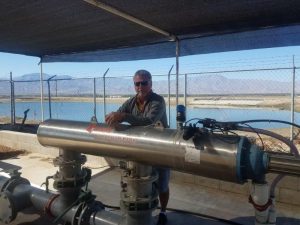
Blaine Carian of Desert Fresh with a new water filtration system funded by SWEEP.
Desert Fresh, Inc, a farm located in the Coachella Valley, in Riverside County, received a $53,000 grant from CDFA’s State Water Efficiency and Enhancement Program (SWEEP) to install climate-smart technology. Desert Fresh grows grapes, lemons, and row crops in some of California’s most arid lands and is doing this while using less water and reducing carbon emissions from the farm.
With SWEEP funding, Desert Fresh installed climate smart technology that reduces irrigation water use by approximately 15 percent while producing the same yield. “How?” you ask. By using precision agriculture technology such as in-field weather stations to monitor wind speed, humidity, temperature, precipitation and evapotranspiration (the transfer of moisture from the Earth’s surface to the atmosphere).
The system utilizes soil moisture-sensing technology to ensure that the plants are getting the exact amount of water they need when they need it. These monitoring technologies identify when the crop is thirsty and know exactly how much water to apply, taking the guesswork out of irrigation.
The SWEEP grant also helped finance a new state of-the-art water filtration system at Desert Fresh to reduce drip-emitter clogging and maintain water distribution uniformity, all while reducing system maintenance. This new filtration system uses a self-cleaning screen filter as opposed to a traditional sand media filtration system. To put this into perspective, a sand media filtration system takes 24 minutes to backflush debris and the installed state-of-the-art filtration system takes 20 seconds to self-clean. This results in much less water required for system maintenance and less energy used by the pump to perform this task. Less pumping results in a reduction in emissions.
When asked about the benefits of the project, the grant recipient, Blaine Carian, stated, “The new filtration station eliminates our drip system’s downtime when cleaning the filter. Technology like this will help ensure that the water pumped into the system is used for irrigation and not system maintenance.”
With this modest investment, California will see almost 23 million gallons of water savings every year and 2.64 metric tons of CO2e reduction per year! That’s the same as driving 6,500 miles less each year! Technology like this will help California meet its climate change goals and adapt to climate change impacts such as water shortage.
This project was supported by the “California Climate Investments” program.
Click here to learn more about accomplishments of the State Water Efficiency and Enhancement Program
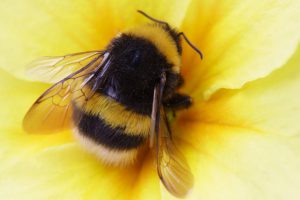
The Foundation for Food and Agriculture Research, a nonprofit established through bipartisan congressional support in the 2014 Farm Bill, has announced 16 grants totaling $7 million for research to address declining pollinator health, an ongoing threat to agricultural productivity in the United States. The FFAR awards are matched by more than 50 companies, universities, organizations and individuals for a total investment of $14.3 million toward research and technology development.
Insect pollinators support crop yields and agricultural ecosystems and contribute an estimated 24 billion dollars to the United States economy annually. New technology, knowledge and best practice guidance tailored to specific regions and land uses has potential to accelerate efforts to improve pollinator health across the United States. Researchers funded through the Pollinator Health Fund are working to address social and economic challenges faced by beekeepers, farmers, home owners and other land managers across the United States.
“Declines in native and managed insect pollinator populations threaten both the agricultural systems that sustain us and the ecosystems that surround us,” said Sally Rockey, Ph.D., executive director of FFAR. “The Foundation for Food and Agriculture Research is pleased to support these 16 research teams who will bring new scientific rigor, best practices and technology to current efforts toward improving pollinator health in the United States.”
The following Principle Investigators are leading research projects supported by the Pollinator Health Fund. Grants were awarded to successful applications to a competitive call for proposals in which applicants were required to secure funding to match the FFAR grant.
To learn more about the FFAR Pollinator Health Fund and these research projects, please visit foundationfar.org/pollinator-health-fund/.
###
CDFA has filed an appeal of a recent Superior Court decision invalidating portions of CDFA’s Programmatic Environmental Impact Report for Pest Prevention and Management. The appeal, filed in the Third District Court of Appeal for California, seeks to overturn the lower court order. CDFA will also request that the court lift an injunction on certain CDFA activities. Going forward, the Department is committed to fulfilling its legislative mandate to prevent the spread of harmful pests while complying with the California Environmental Quality Act to ensure the protection of agriculture, the environment and other natural resources.
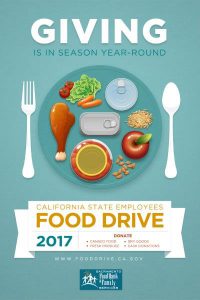
The final numbers for 2017 State Employees Food Drive are in and we are very pleased to note an increase in food donations compared to 2016!
CDFA and its Office of Farm to Fork coordinated the food drive from late September to early February, along with their partners at the Sacramento Food Bank and Family Services and 108 different assistance agencies statewide.
We set an ambitious goal for the year–800,000 pounds–and almost got there. The 2017 total was 783,683 pounds, the equivalent of 648,000 meals to needy families! It’s an amazing accomplishment and on behalf of Sacramento Food Bank & Family Services, I want to thank all state employees for making this possible.
The need for food in California is substantial. According to the California Association of Food Banks, 5.4 million Californians contend with food insecurity, which is defined as the occasional or constant lack of access to the food one needs for a healthy, active life. More than two-million of those people are children. That need is what motivates California state employees to commit to this effort each and every year!